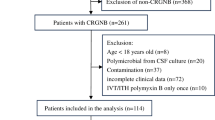Summary
In this study, the author attempts to question the necessity of prolonged antimicrobial treatment for intracranial abscess. The C reactive protein (CRP) was measured serially in 26 patients with intracranial abscess. All patients had undergone surgery and were treated with antimicrobial therapy. The CRP was elevated in 20 (77%) patients and its return to normal after treatment correlated with a good recovery. In 3 (12%) patients a persistently high CRP level postoperatively coincided with reformation of the abscess. A transient rise in the CRP value during decrease to normal was due to deep venous thrombosis in 2 (8%) patients. The return of the CRP to normal in conjunction with improvement of the patient's clinical condition and evidence of resolution of the abscess on CT scan were used as a guideline to stop antibiotics early. The antimicrobial therapy of the patients in this series ranged from 11–30 (mean 20) days and the follow up from 6–36 (median 21) months; there have been no recurrences.
Similar content being viewed by others
References
Bennish M, Beem MO, Ormiste V (1984) C reactive protein and zeta sedimentation ratio as indicators of bacteremia in pediatric patients. J Pediatr 104: 729–732
Dinarello CA (1984) Interleukin-1 and the pathogenesis of acute phase response. N Engl J Med 311: 1413–1418
Grimstad IA, Hirschberg H, Rootwelt K (1992) 99 mTc-hexamethyl propylene amine oxime leukocyte scintigraphy and Creactive protein levels in the differential diagnosis of brain abscesses. J Neurosurg 77: 732–736
Hirschberg H, Bosnes V (1987) C-reactive protein levels in the differential diagnosis of brain abscesses. J Neurosurg 67: 358–360
Icord P, Fleury JP, Regnard JFet al (1994) Utility of C-reactive protein measurements for empyema diagnosis after pneumectomy. Ann Thorac Surg 57: 933–936
Jamjoom AB, Jamjoom ZAB, Al-Hedaithy SS (1994) Actinomycotic brain abscess successfully treated by burr hole aspiration and short course antimicrobial therapy. Br J Neurosurg 8: 545–550
Maurice-Williams RS (1989) Intracranial abscess. Hosp Update 2: 118–126
McCartney AC, Orange GV, Pringle SDet al (1988) Serum C reactive protein in infective endocarditis. J Clin Pathol 41: 44–48
Miettinen AK, Heinonen PK, Laippala P, Paavonen J (1993) Test performance of erythrocyte sedimentation rate and Creactive protein in assessing the severity of acute pelvic inflammatory disease. Am J Obstet Gynecol 169: 1143–1149
Nakamura H, Uetani Y, Nagata T, Yamasaki T (1980) Serum C-reactive protein in early diagnosis of neonatal septicaemia and bacterial meningitis. Acta Paediatr Jpn Overseas 31: 567–571
Palosuo T, Husman T, Koistinen J, Aho K (1986) C-reactive protein in population samples. Acta Med Scand 220: 175–179
Peltola H, Valmari P (1984) C-reactive protein in meningitis. Lancet 1: 741–742
Pepys MB (1981) C-reactive protein for rapid monitoring of infections in the central nervous system. Lancet 1: 653–656
Pepys MB, Blatz ML (1983) Acute phase proteins with special reference to C-reactive protein and related proteins (Pentaxins) and serum amyloid A protein. Adv Immunol 34: 141–212
Rehncrona S, Brisma J, Holtas S (1985) Diagnosis of brain abscess with indium-III labeled leukocytes. Neurosurgery 16: 23–26
Rosenblum JL, Hoff JT, Norman Det al (1980) Non-operative treatment of brain abscesses in selected high risk patients. J Neurosurg 52: 217–225
Schulitz KP, Assheuer J (1994) Discitis after procedures on the intervertebral disc. Spine 19: 1172–1177
Strong AJ, Ingham HR (1983) Brain abscess. Br J Hosp Med 12: 396–403
Author information
Authors and Affiliations
Rights and permissions
About this article
Cite this article
Jamjoom, A.B. Short course antimicrobial therapy in intracranial abscess. Acta neurochir 138, 835–839 (1996). https://doi.org/10.1007/BF01411262
Issue Date:
DOI: https://doi.org/10.1007/BF01411262




